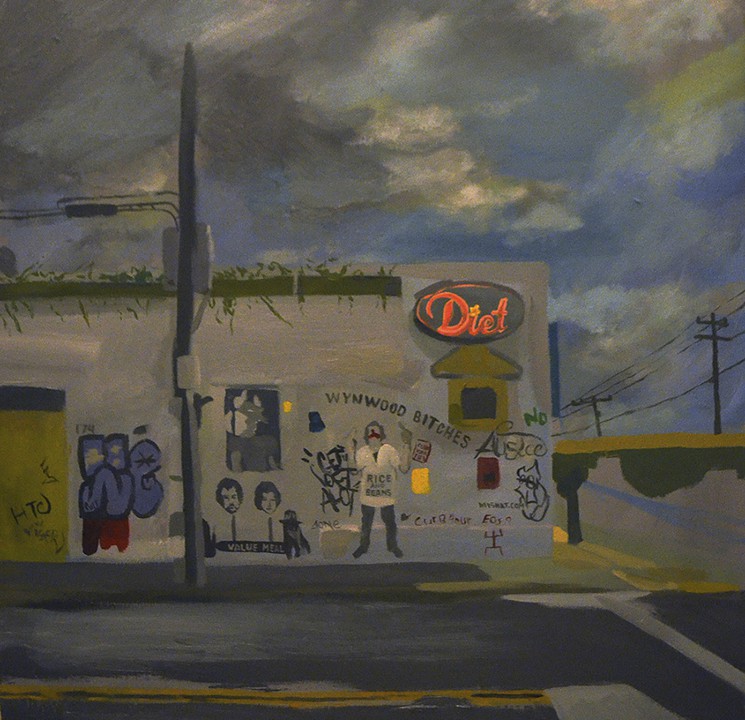Broward Palm Beach New Times, September 15, 2015
The Art and Culture Center of Hollywood is a quaint yellow building with stately palm trees and well-landscaped shrubbery. Usually, it’s the art inside that’s controversial — not the politics surrounding the place. But over the summer, Jane Hart, who had been the curator for eight years, and who was instrumental in building the center’s reputation as a standout in the contemporary art scene, left the institution amid rumors of friction with administrators. As “an act of solidarity,” two high-profile curators who were slated to serve as jurors for a major upcoming art show likewise stepped down.
Though the well-loved Hart has not been replaced, the center seems to be managing fine so far with independent curators. Another well-admired denizen of the local art scene stepped in to save the day just in time for one of the ACCH’s most important shows: the Seventh All-Media Juried Biennial. One of the most significant art events in the state, Hollywood’s Biennial takes place every other year. Awards will go to Best in Show, First, Second, and Third places as well as Honorable Mentions.
Michele Weinberg is curating the show. Weinberg is the creative director of Girls’ Club gallery in Fort Lauderdale. She has designed a mosaic for Hollywood ArtsPark colored-asphalt crosswalks and sidewalks in Tampa, and murals for Celebrity Cruise Lines and for Facebook’s Miami offices. Lately, she’s been doing thought-provoking but playful pattern work with tiles and rugs.
For the Biennial, which has an opening reception on the evening of Friday, September 18, nearly 400 established and emerging artists from across Florida (the contest is open only to state residents) submitted their work for consideration. Of their 1083 entries—which ran the gamut from paintings, sculptures, performances, video, computer-generated images, and installations tailored especially for the site—only 88 pieces made the cut.
Weinberg explains that the jurors — including Elizabeth Cerejido, a former curator at Houston’s Museum of Fine Arts, and and Marisa J. Pascucci, a curator at the Boca Raton Museum of Art — picked “the most realized” works, works that have some “sort of statement that’s gelled and is alive in that piece.” She characterizes the art included in the show as “risky and inventive,” and said that much of it “has a narrative to the storytelling.”
While the layperson such as myself might not always see the narrative, the works are provocative in the least. Justin Gaffey’s “Attached”—composed of steel, acrylic, string, and graphite on a wood panel—offers a female figure that partially obscured by red threads. The strings are taut, evoking a feeling of tension. The image asks the viewer to consider, perhaps, the nature of our relationships: do they support us or tie us down? Is the woman’s weight straining the threads? Or do ties that bind pull on her?
Molly Khorasantchi’s vibrant oil on canvas “Roots of Feelings 2” is slightly more abstract. A coiled orange line—its size inconsistent, its edges undefined—stands against a backdrop of assorted colors and shapes. Small blocks of geometric forms appear occasionally, emerging from an image that is at once chaotic and coherent.
Jane duBrin’s “posing” presents a haunting image rendered in vine charcoal on canvas. The portrait depicts a man or woman, eyes closed, facing the viewer. We don’t get details, only the contours of the person’s face. The effect is an ethereal image that reminds of the fleeting, transient nature of existence.
To this casual viewer, Eddie Arroyo’s work feels particularly relevant to the South Florida location of the biennial. The acrylic on canvas “1 NW 62nd Street Miami, FL 33150”—one of Arroyo’s intriguing “Miami Portraits” series—seems to offer some commentary on the South Florida art scene. Although it depicts a corner in Little Haiti, adjacent to Wynwood, the latter is referenced in graffiti that’s been hastily scrawled on the wall of a local business. Considering a portrait of place, which references another place, has a profound effect on the viewer.
Like other “Miami Portraits,” no people appear in this image. The only figures that are present in the series are those that are depicted in the street art or advertisements that are part of the landscape. It begs the question: is a Miami empty of its inhabitants still Miami? What is a place without its people?
Award winners will be announced at the opening reception and will receive cash prizes ranging from $2000 to $400. The reception will be held from 6:00 to 9:00 PM and is free to ACCH members. Non-members may attend for $10; tickets will be available at the door and credit cards will be accepted. The bar will be open and light hors d’oeuvres will be served.
Autumn Casey’s “Waiting in Purgatory but at Least There’s Chairs and it Feels Musical” will appear at the ACCH alongside the biennial. Casey’s installation includes video and sculpture and blends found objects with items from the artist’s personal life—resulting in an experience of “existential uncertainty,” according to the ACCH’s website.
Also on display will be the exhibition #acchfocus, consisting of 52 winning images from the ACCH’s 2013-2014 Instagram contest.
The Biennial exhibition will run September 19 through November 1.
